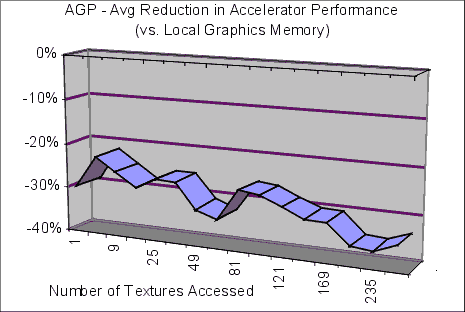Does AGP Really Improve Performance?
30% Reduction In Accelerator Performance
Intel has developed a software tool which is useful in comparing the performance of AGP vs. Local texturing modes. It is called IBASES. As a matter of principle though, I do not recommend this tool to anyone. IBASES does not support AGP DMA mode texturing. Instead of AGP DMA mode, it substitutes the extremely useless CPU copy mode (method #2 above). Oddly enough, the software still refers to this as "DMA Mode". This is clearly NOT a mistake, but rather a blatant attempt to deceive. For anyone using this tool, results from the "DMA" test should be completely disregarded. One should instead assume that AGP DMA mode results would be about the same as AGP Execute mode.
I evaluated local vs AGP texture performance of the following accelerators:
ATI Rage Pro
3D Labs Permedia 2
nVidia Riva 128
The program allows the user to change the number of times the textures are accessed per frame. This has the effect of gradually increasing the total texture bandwidth demand. As seen over AGP, the texture bandwidth demand created by IBASES in the chart below ranges from 256K per frame at the left extreme, up to 4 megaBytes per frame at the right extreme of the chart.
The chart shows the average difference in rendering performance for all of the accelerators using AGP Execute mode texturing, compared to local graphics memory. This data demonstrates that overall, AGP execute mode is about 30% slower than local texture mode.
Get Tom's Hardware's best news and in-depth reviews, straight to your inbox.
Current page: 30% Reduction In Accelerator Performance
Prev Page Technical Background Next Page 10% Reduction In CPU Performance